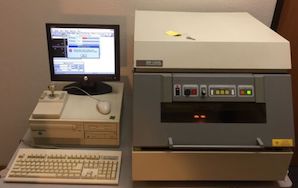
-----
Clean gold coating formulation
2003
Need to deposit heavy (say 5 micron) and 'flat' pure gold on copper parts with spots of electronics solder.
We cool diode strip lasers with copper parts (water circulates inside).
These parts we were coating with commercial EN + gold, but the process gives much trouble and I have been asked to reformulate.
Gold needs to be pure (soft) so that it adapts to laser strips been held, and I cannot locate commercial products, available here, that do not contain cobalt.
Not to seem lazy, I cannot wait 4 weeks to get books and cannot find on the internet complete reliable formulations.
Tried with 10 g/L Au as KAu(CN)2, 90 g/L KCN and 10 g/L K2HPO4, after first 0.5 - 1 microns the coat gets greenish-spongy. Raising temp to 50 °C it seems to work, but at the microscope it looks rough. Changing current from 1 to 10 mA/cm2 has no effect.
Should mention our surfaces are say 1x1 inch, flat, with 50 nm (really! diamond cut) roughness.
Volumes being small, would not use citrate or sulphite because of air oxidation.
So, any good soul there could help me formulate a bath:
- to electrochemically coat copper with clean pure gold, > 5 microns
- cyanide based
- including brighteners, levelers, etc.
- room temperature or above
- reasonably idiot proof, stable in time.
Should also mention: I'd love to ship to coat elsewhere, but with the 50nm roughness @ flatness specs, parts cannot travel, so professionals there should forgive me for trying this on my own. I am a chemistry PhD but have no experience in precious metal deposition. Thank you in advance.
Marco
Marco Caceci- Vilanova, BCN, Spain
2003
Dr. Caceci, the thing is, books or no books, you are very unlikely to find a fully suitable generic formula published anywhere. The economic basis for how the plating industry has worked for many decades now has been through the development and sale of plating baths employing proprietary brighteners, levelers, and addition agents. In some cases these addition agents are not mixes anyway, but compounds synthesized from precursors, and no supplier will share their synthesis protocols with you even if you are set up to do syntheses of this sort..
Sorry we can't be of more help. I understand your situation, but the information you are seeking is all trade secret. Suppliers like Macdermid, Technic, etc., can offer cyanide gold or other plating baths that will meet your needs.
I do advise you, though, that the nickel interlayer you were using may be a necessity (what problems did it give you?) because the gold and the copper will interdiffuse.

Ted Mooney, P.E.
Striving to live Aloha
finishing.com - Pine Beach, New Jersey
Ted is available for instant help
or longer-term assistance.
Dear Dr. Caceci,
Hi! Since you are speaking of some books here, could you please let me know which books would help me in learning more about practical gold micron coating. I am unable to get names of any books/ authors for a project I wish to undertake.
Thanks and regards,
Rajendra Singh Vermasilver/ pewter - Agra, UP, India
2005
2005
Hello, Rajendra. A micron is, of course, a measure of thickness equal to one millionth of a meter. But does the term 'micron plating' mean anything in particular to you? I ask because I am unfamiliar with it having any special meaning, but I might be missing something. I see advertisements for objects with 'high micron plating', which just means 'high thickness plating'; I see talk about '3 micron plating', which means plating that is 3 microns thick.
So maybe what you are looking for is simply good books about gold plating? "Gold Plating Technology" by Reid & Goldie is rather pricey, but many have said it's a good book on the subject.

Ted Mooney, P.E.
Striving to live Aloha
finishing.com - Pine Beach, New Jersey
Ted is available for instant help
or longer-term assistance.
I'd like any information on how gold plating works. Is it the longer you plate some thing the higher in Microns it will become? and how can you test the micron plating on jewelry?
Wendy Youngproduct designer - London U.K.
April 14, 2009
Hi, Wendy. Yes, you've pretty much got it: Current x time = the number of electrons you've transported, and a corresponding number of molecules of gold cations will plate out to match those electrons. See Faraday's Law for actual calculations.
There are a number of instruments for thickness testing, based on x-ray fluorescence and other technologies; but the easiest way is to count the electrons with an ampere-minute meter connected to your rectifier.
Regards,

Ted Mooney, P.E.
Striving to live Aloha
finishing.com - Pine Beach, New Jersey
Ted is available for instant help
or longer-term assistance.
Q, A, or Comment on THIS thread -or- Start a NEW Thread
